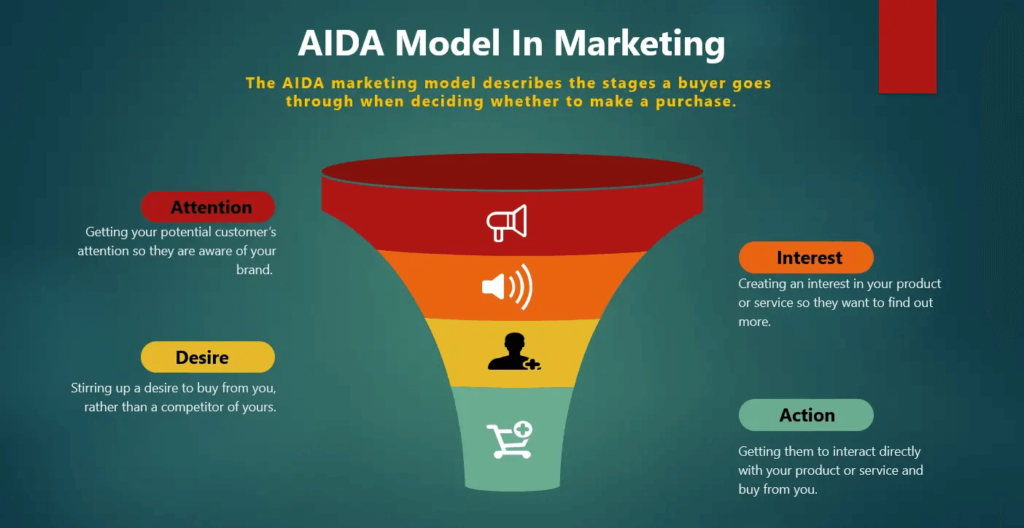In the world of advertising and marketing, the AIDA Model is one of the most effective frameworks for crafting persuasive messages that grab attention and drive action. Whether you’re creating Facebook ads, writing an email campaign, or developing landing pages, the AIDA model provides a structured approach to guide your audience through their decision-making journey.
In this blog, we’ll break down the AIDA model and explore how you can use it to create high-converting ad copy.
What is the AIDA Model?

AIDA stands for Attention, Interest, Desire, and Action. This model outlines the four key stages that a potential customer goes through before making a purchase or taking any other desired action.
- Attention: Capturing the audience’s attention.
- Interest: Keeping them interested by highlighting their needs or problems.
- Desire: Building a desire for the solution you’re offering.
- Action: Encouraging them to take the next step, whether it’s signing up, buying, or learning more.
Let’s explore how each stage works in creating ad copy.

1. Attention: Grab Your Audience’s Focus
The first step of the AIDA model is to capture your audience’s attention. In the fast-paced world of online advertising, users are bombarded with content, and your ad needs to stand out.
- How to Do It:
- Use bold headlines.
- Make a strong, attention-grabbing statement.
- Ask a thought-provoking question.
- Use eye-catching visuals.
Example: “Struggling to grow your online business? 🚀”
This headline immediately targets a pain point and gets the user thinking about their problem.

2. Interest: Keep Them Engaged
Once you’ve grabbed their attention, the next step is to generate interest. Your ad copy should speak to the audience’s needs, pain points, or desires. This is where you highlight the value of your product or service.
- How to Do It:
- Emphasize the benefits of your product or service.
- Show empathy toward their problems.
- Provide a solution that sparks their curiosity.
Example: “With our powerful social media tools, you can increase engagement, drive more traffic, and grow your business faster than ever.”
Here, the copy builds interest by explaining how the product can address the user’s pain point of slow business growth.

3. Desire: Create a Strong Want
Now that they’re interested, it’s time to create a desire for your product or service. This step involves convincing your audience that they need what you’re offering. You want them to imagine how their life or business could improve by using your solution.
- How to Do It:
- Highlight the unique selling points (USPs) of your product.
- Use social proof like testimonials or reviews.
- Offer a limited-time discount or bonus.
Example: “Join 1,000+ business owners who have doubled their revenue using our platform. Sign up today and get a 30% discount!”
This copy builds desire by showing that others have successfully used the product and offering an incentive (the discount).

4. Action: Motivate Them to Act
The final step is to push the audience to take action. You need a clear and compelling call to action (CTA) that guides them toward the next step, whether it’s signing up, purchasing, or downloading.
- How to Do It:
- Use action verbs like “Buy,” “Download,” “Get Started,” or “Learn More.”
- Create urgency with phrases like “Limited time offer” or “Act now.”
Example: “Sign up now and transform your business in just 30 days. Don’t miss out on this exclusive offer!”
This CTA is clear, action-oriented, and creates a sense of urgency, pushing the user to act immediately.
Why is the AIDA Model Effective in Ad Copy?

The AIDA model is effective because it addresses each stage of the buyer’s journey, making sure you don’t lose the audience at any point. It ensures that your ad copy flows naturally from grabbing attention to inspiring action.
- Clear Structure: It gives your ad a logical flow that guides the reader step-by-step toward the final action.
- Focuses on the Audience: The model encourages you to focus on the customer’s needs and desires, not just the features of your product.
- Increases Conversion: By leading the reader through each stage, the AIDA model boosts the chances of conversion.
How to Use the AIDA Model in Different Platforms
- Facebook Ads: You can use the AIDA model to structure your Facebook ad copy by starting with a bold headline, keeping the audience engaged with benefits, creating desire with social proof or a discount, and ending with a strong CTA.
- Email Marketing: In emails, grab attention with a powerful subject line, generate interest with valuable content, create desire by showcasing how your product solves a problem, and end with a CTA that directs the reader to take action.
- Landing Pages: On landing pages, the AIDA model works by guiding visitors from the headline through the benefits of your offer and testimonials, then pushing them to click a CTA button.
Conclusion
The AIDA model is a proven framework for creating persuasive ad copy that drives results. Whether you’re running a Facebook ad, writing a landing page, or crafting an email, this model helps you connect with your audience, keep them engaged, and move them toward action. By mastering the AIDA model, you can create ads that not only capture attention but also generate conversions, building long-term success for your business.
Connect with me on social media!

